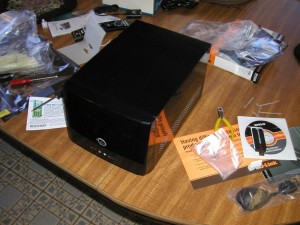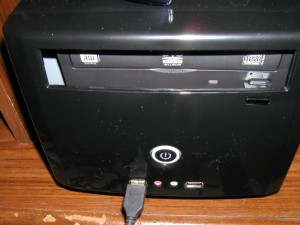The Finished Product
I introduce to you the finished product along with a glorious mess as a consequence of its construction:
Don’t worry, I cleaned up the mess! (Sorta.)
I would also like to share a shot of the back panel:
It’s a cute little beast.
…but not without some modification!
It’s unfortunate, but the molded, polished door designed to give the case a certain degree of uniformity and flair is a bit too sturdy for the optical drive to open. After powering up the unit, attempting to eject the tray yielded a disturbing shortcoming: The spring that holds the door shut is so strong that the optical drive was struggling to open it. I wasn’t about to burn out the tray, so I made a modification to the unit. I removed the spring.
In this picture, you’ll notice that there isn’t any little metal hook in the center of the hinge to hold the door shut. I elected to remove the spring and discovered much to my delight that the door will still stay shut due to the direction it slants when it is flush with the case. Unfortunately, I also ran into one final design problem. When the door is in its open state, accessing the eject button is nearly impossible. Bummer.
So, I did what any geek would do. I removed the damn thing.
Maybe I need tiny fingers. I don’t think that’d work, though. I’m sure my mum wouldn’t be able to press that stupid button.
So, there you are: A couple of hours of construction intermingled with a few minor interruptions, some changes in plans, and a little bit of modification to get a pretty decent home theater PC up and running. I’ll be discussing the software decisions in part 2. If you’re interested in my review of the hardware itself, keep reading.







2 Responses to “Atom-based Media Center: Part 1”
Took me awhile to get around to reading this but very informative! Your shopping list of hardware and the picture examples were a lot better than some of the sites I read on the topic of mythtv type boxes and hardware. It helps to have visual examples and it’s too bad a lot of pages dont seem to be very creative in that sense. I look forward to seeing the next part about the software.
I’ve started saving up to get some of the hardware so this way I can start building sooner rather than later.
One thing I think I didn’t stress much in the article is that the Intel 945-based boards are a little under powered (or feel that way). The NVIDIA Ion systems might be a bit more appropriate, but I haven’t found one that has a decent expansion option! I’m hoping this will change. All things considered, though, the Atom 330 + i945 is a pretty decent mix for a basic HTPC. It probably won’t do HD well and flash movies are a little jerky (maybe it’s just the Youtube videos–some of them are pretty awful quality-wise).
If you want something a little more powerful, there’s a lot of mini-ATX boards out there that support Core 2 systems–I even found one by SuperMicro that’s based on the Atom. Though, one thing about the Core boxes–they can’t beat the Atom when it comes to power consumption. I think the processor idles at about 8 watts.
Leave a comment